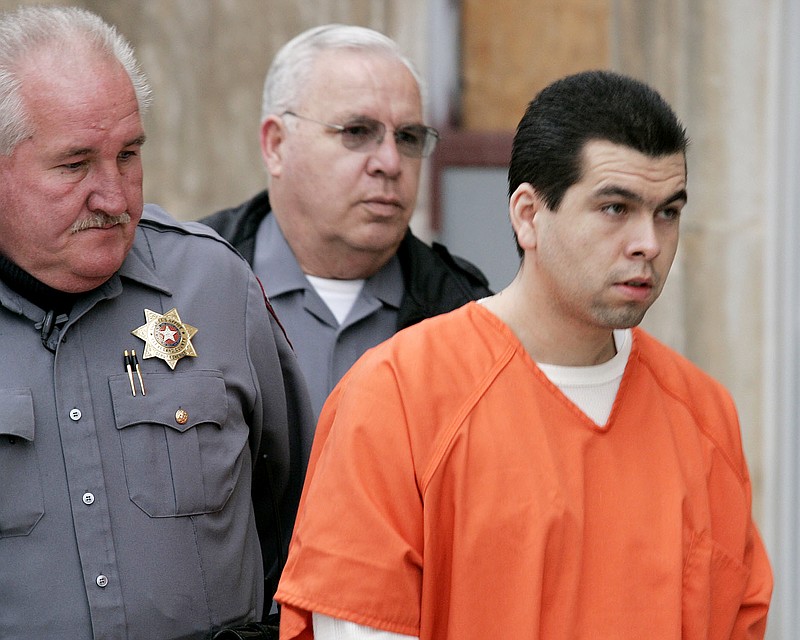McALESTER, Okla. -- Oklahoma executed an inmate Thursday for the 1996 killing of a University of Oklahoma dance student, in a case that went unsolved for years until DNA from the crime scene was matched to a man serving prison time for burglary.
Anthony Sanchez, 44, was pronounced dead at 10:19 a.m. after a three-drug injection at the Oklahoma State Penitentiary in McAlester. Even though he maintained that he had nothing to do with the killing of 21-year-old Juli Busken, he took the unusual step of opting not to present a clemency application to the state's Pardon and Parole Board, which many viewed as the last chance to spare his life.
"I'm innocent," Sanchez said as he was strapped to a gurney inside the death chamber. "I didn't kill nobody."
Sanchez criticized his former attorneys and thanked his supporters, including his spiritual adviser who was in the chamber with him and the anti-death penalty group Death Penalty Action.
The lethal drugs, beginning with the sedative midazolam, were administered starting at 10:08 a.m.
At one point during the execution, a member of the execution team entered the chamber and reattached an oxygen monitor that prison officials said had malfunctioned during the procedure.
Shortly before he was put to death, the U.S. Supreme Court rejected a request for a stay of execution submitted by his new lawyer, Eric Allen, of Columbus, Ohio. Allen had said he needed more time to go through the case evidence.
Sanchez was convicted of raping and murdering 21-year-old Juli Busken, a Benton, Ark., native who had just completed her last semester at the university when she was abducted on Dec. 20, 1996, from the parking lot of her Norman apartment complex. Her body was found that evening near Lake Stanley Draper in far southeastern Oklahoma City. She had been bound, raped and shot in the head.
Busken had performed as a ballerina in several dance performances during her tenure at OU and was memorialized at the campus with a dance scholarship in her name at the College of Fine Arts.
Oklahoma University President David Boren was acquainted with Busken during her time on campus. He watched the dance major perform in the musical Swan Lake the semester before she was killed
"She had a beautiful spirit about her," Boren said during an interview with Oklahoma television station KWTV in 2011. "Even when you just saw her walking across campus in her everyday street clothes, you felt she walked with such dignity and grace that you'd say to yourself, 'I bet she's a ballet dancer.'"
Years later, Sanchez was serving time for a burglary conviction when DNA from sperm on Busken's clothing at the crime scene was matched to him. He was convicted and sentenced to die in 2006, with an appeal denied in 2009.
None of Busken's family attended Thursday's execution, but state Attorney General Gentner Drummond said he had spoken to them several times in recent months.
"Juli was murdered 26 years, nine months and one day ago. The family has found closure and peace," Drummond said.
Sanchez has long maintained his innocence and did so again in a phone call to The Associated Press earlier this year from death row. "That is fabricated DNA," Sanchez said. "That is false DNA. That is not my DNA. I've been saying that since day one."
Drummond maintained that the DNA evidence unequivocally linked Sanchez to Busken's killing.
A private investigator hired by an anti-death penalty group contended that the DNA evidence may have been contaminated and that an inexperienced lab technician miscommunicated the strength of the evidence to a jury.
Former Cleveland County District Attorney Tim Kuykendall, who was the county's top prosecutor when Sanchez was tried, has said that while the DNA evidence was the most compelling at trial, there was other evidence linking Sanchez to the killing, including ballistic evidence and a shoe print found at the crime scene.
"I know from spending a lot of time on that case, there is not one piece of evidence that pointed to anyone other than Anthony Sanchez," Kuykendall said recently. "I don't care if a hundred people or a thousand people confess to killing Juli Busken."
During a 2011 KWTV interview, Kuykendall said there was no indication the night before Busken's murder that the December night was unusual.
"The night before, she'd been out with some friends," Kuykendall said. "They had a going away party, a Christmas party, saying their goodbyes. They thought their goodbyes were for the semester, until after Christmas. Little did they know that their goodbyes would be forever."
Information for this article was contributed by staff writers of The Associated Press and the Arkansas Democrat-Gazette.
